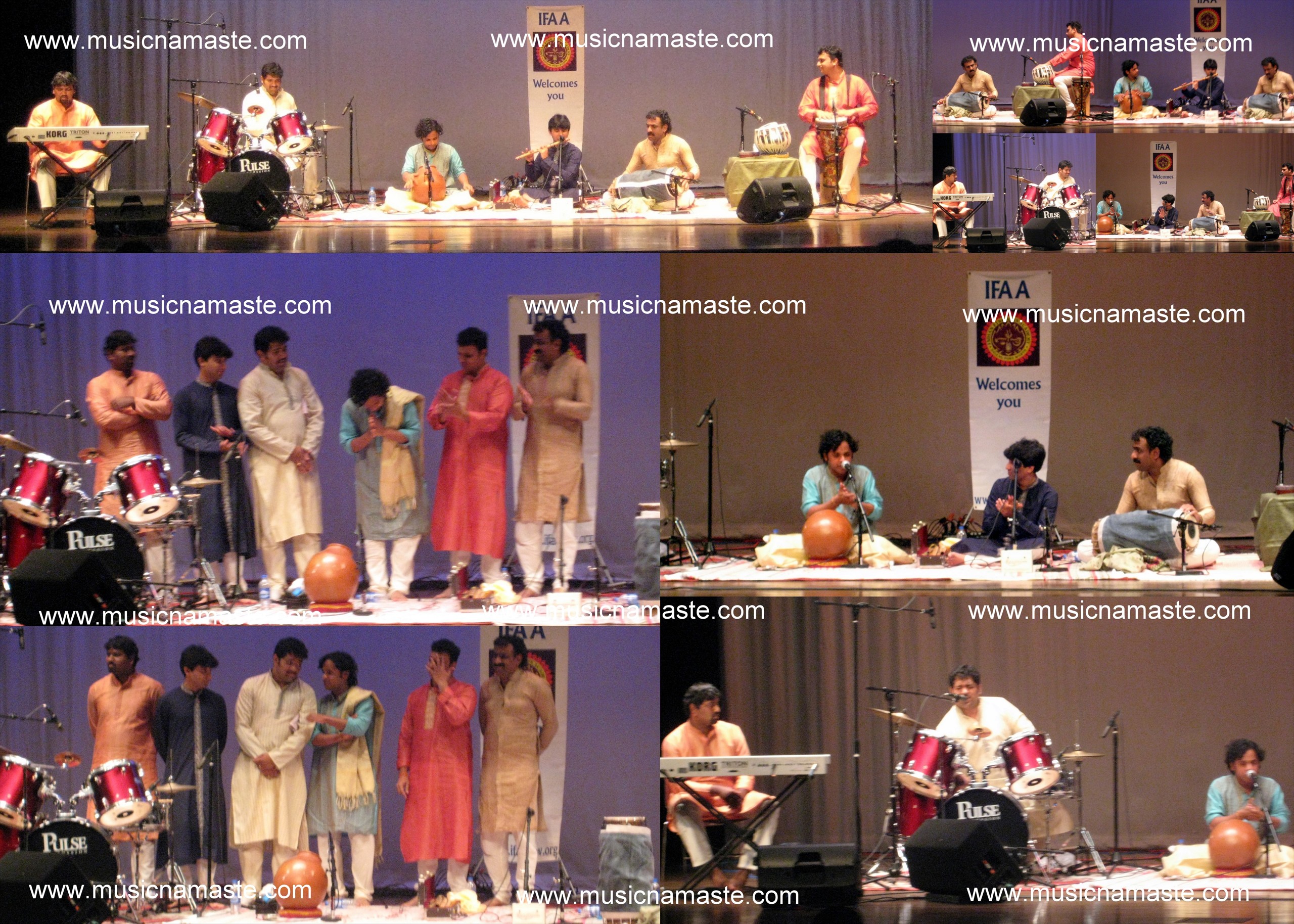Concert by Layataranga
May 24 2009
Allen, TX
This was my first live concert on fusion Carnatic music. I went in with a lot of anticipation. I greatly enjoy fusion music, one of my recent flavorful expeditions was with the movie “Morning Raga” which had several beautiful melodies in a fusion ensemble.
The concert was arranged by IFAA Dallas. This was Layataranga’s first US tour and the first time ever performance in Dallas.
Team of Layataranga that visited Dallas is as follows –
Giridhar Udupa on Ghatam
Jayachandra Rao on Mridangam
Pramath Kiran ( Tabla, Morsing and Djembe )
Arun Kumar on Drums
RajKamal on flute ( Guest artist )
Soloman on Keyboard
The concert began with the popular kriti Mahaganapathim set to Raaga Natai and Taala Eka. The rendition began with the mellifluous flute from RajKamal and as the Kriti launched into its full beauty, the percussion ( Ghatam, Mridangam, Djembe and Drums ) joined in unision and with great gusto! The blend was simply astounding! The audience was enthralled with this cohesive spirited performance.
Let me just take a moment here to put in a note about the instruments used.
Ghatam, Mridangam and Morsing are Carnatic percussion instruments. These are seen in Carnatic concerts. Drums are western percussion instruments ( reminds you of the popular movie Drumline ). Keyboard is also a western instrument, well adapted these days to all kinds of music. Djembe is a popular African percussion instrument. Flute can be again a versatile instrument used in Carnatic or Hindustani renditions. Tabla is a popular Hindustani percussion instrument.
Wow, that is an impressive ensemble of world musical instruments!
Getting back to the concert, the next rendition was the Tyagaraja kriti Vandanamu, set to Raaga Sahana and Taala Adi ( 8 beats ). This rendition too began with the flute and keyboard. While the main piece caught momentum, the percussion ensemble rose to the occasion majestically. This was a relatively slower paced rendition. Tabla spoke during this rendition and Djembe remained silent.
The following rendition was explained by Ghatam Udupa as their own composition called “”Anandam”. This composition is part of their new album. Anandam is set to Raaga Nalinakaanti. The theme of this composition Anandam ( happiness / joy ) was rendered beautifully.The rendition was initiated with Morsing, followed by Ghatam, Mridangam, Drums, keyboard, Djembe and so on. Truly innovative.
The following renditions included the beautiful song Alaipayuthe, a new song called – “Forget Me Not”. The song “Forget me Not” came out beautifully on the piano and flute. Very moving piece!
The main piece of the concert was probably one of the rarest moments of Carnatic music. This is because of two rare aspects that were demonstrated – 1. A very soul satisfying Tani Avartanam 2. A very versatile and momentous Konnakol by Giridhar Udupa ( Ghatam), Pramath Kiran ( Djembe, Tabla, Morsing ) and

Layataranga in concert
.. Both of these are really rare to find in a regular Carnatic music concert. Konnakol in the olden days used to be a tradition in the Carnatic music concert, but off late is rarely demonstrated. During this rendition the Tani Avartanam included the western drums and the African Djembe also, which was a seamless blend. Almost all areas of Ghatam was demonstrated. Ghatam Udupa also demonstrated the Konnakol with implementation on the Mridangam by Jayachandra Rao. The instruments came alive with their upbeat Konnakol talk and the Ghatam flew in the air to show its pot magic! The audience gave a standing reverberating ovation!
Concert was concluded with the popular Devara Naama Krishna Nee Begane Baaro and Bhagyada Lakshmi Baramma.
Well, that was quite a ride!
Layataranga band ( as I would like to call it ), not only is about world fusion music based on Carnatic music, but also its core is the concept of Laya. Laya means rhythm. The core of Layataranga is the Laya, the rhythm of music. In their music, rhythm came out very royally and to its maximum beauty I have ever seen.
All the musicians in the team/band are very accomplished and multitalented. But what strikes out is their passion for each other’s music, their belief in each other’s prowess and of course their passion for Laya. Even though western instruments were used, not even once did the music deviate from the framework of Taala.
Traditional concerts mainly have a primary musician and the percussion artists accompany the primary artist. The duration of Tani Avartanam is not enough for the rhythm admirer. Our body is naturally rhythmic like a heart beat and hence rhythm has a very positive effect on it. It was refreshing to see the Laya displayed to its full grandeur.
Let me also say that the audience was very open minded and receptive. It is not easy for traditional people to accept the modern day changes on the classical music.
May Laytaranga continue to create the magnificient waves of Laya. Wishing them all the very best!
